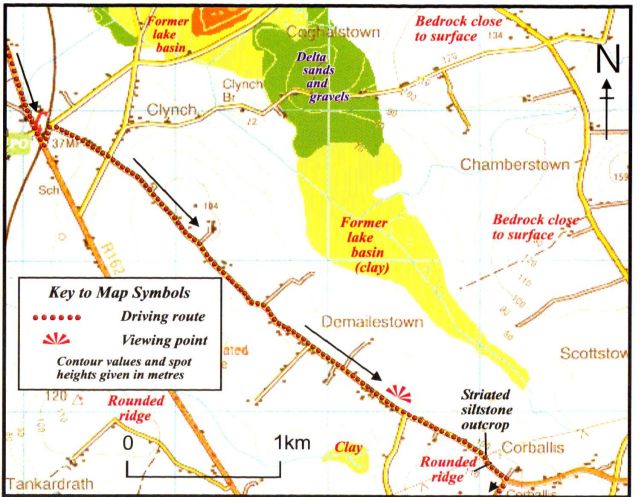Nobber to Navan
Source:
The Boyne Valley in the Ice Age
Robert T. Meehan & William P. Warren
The Geological Survey of Ireland
.
Nobber is the birthplace of the last of the Irish Bards, Turlough O’Carolan, who was born in 1670. He traversed the northern half of Ireland as a travelling bard, and wrote more than 200 pieces of music. An Irish music festival in held in his honour at Nobber each summer.
One of the best views of the drumlins in the area occurs just north of Nobber village, where the road bends around to the right. West of the village, close to the River Dee, some hummocks can been seen. Hummocks are small irregular shaped hills, generally occurring in clusters. These are moraines. A moraine is a mound or ridge of unsorted and unstratified glacial debris, deposited commonly at the ice margin. Glacial debris is material being transported by a glacier in contact with glacier ice. The ice margin is the edge of an ice sheet or glacier. The first five kilometres of the road between Nobber Village and Castletown is quite like a roller coaster as it rises up and down over the humpbacked drumlins.
Driving south from Nobber drumlins dominate the landscape. Passing Cross Guns Pub and Mullens Cross Roads, the drumlins die out and are replaced by smaller, more haphazard, 5m to 6m high hummocks which are comprised of sorted gravel. These are exposed in the road cutting at Darby’s Cross Roads. The gravels here record the huge amounts of meltwater that existed in this area flowing from the drumlin region during deglaciation. Turn left at Wilkinstown and then right towards Demailstown. A deep valley is visible on the left hand side after 2 km or so. Stop at the T junction with the minor road going towards Kilberry.
Demailstown is only three miles from Teltown, site of one of the four royal palaces of Ireland in ancient times. It was also the location of the Tailtean Games, an annual gathering of sport similar to the Olympics of ancient Greece. The games were held on the first of August from the 15th century B.C. to as late as the 12th century A.D.

The view east at Demailstown across the valley is quite interesting and records the complex development history of the valley. The highest ridges are bedrock cored with a thin covering of till in some places; furze bushes often indicate areas where rock is outcropping. On the north side of the bedrock ridge (Mullagha Hill) directly opposite a flat topped feature is seen, with houses built across its crest. This flat topped feature is a delta and is composed of bedded sands and gravels. A delta is a fan shaped plain of alluvial sediments at river mouth upon entry into the sea or lake which is crossed by many distributaries, often extending beyond the general trend of the coastline or lake shore. Alluvial sediments are sediments deposited by fluvial (river) processes.
At the end of deglaciation ice had so reduced in thickness that only a tongue of ice covered the valley floor, with its front retreating towards the north. The ice stood still at the northern side of the valley and a large lake formed from the meltwater, filling the valley up to between the 80 and 90 metre contour. Meltwater rivers flowing off the ice at the northern side of the valley deposited sorted sands and gravels as a delta: then as the ice retreated further north the meltwater filling the valley drained away northwards via the meltwater channel at Clynch Bridge. The delta was then left standing as it is today, a relict feature of sands and gravels. The floor of the valley at Demailstown is covered in poorly drained glaciolacustrine silts and clays which were deposited while the lake was in existence. Glaciolacustrine pertains to lakes made up of meltwater from glaciers or ice sheets. These lakes may or may not be dammed on one or more sides by the ice itself.
Nearby , just inside the field on the west side of Corballis Cross Roads, there is an old quarry. The siltstone rock cropping out of the quarry has been striated along a west east plane. Measuring the striae provides valuable information about ice flow over the area during the last glaciation. Striae are ice scratches on rock surfaces caused by debris carried by moving ice.
Driving between Demailstown and Simonstown.
Between Kilberry and Navan the ground is covered with a veneer of till, hence the well developed, fertile valleys with thick topsoils. Crossing the top of Proudstown Hill the bedrock can be seen cropping out at the roadside. The outwash plain at Simonstown is best seen at the base of Proudstown Hill. Outwash pertains to rivers made up of meltwater from glaciers or ice sheets. Looking west, the flat surface of the plain can been to terminate in a series of small hummocks on the western horizon. This is where the ice margin stood at the time of deposition of the outwash gravels. The extensive Kilsarn Gravel Pit can be seen and can accessed by turning right at the lane beside the Navan Tyre Centre. The gravels in the Kilsarn Pit are organised in extensive horizontal layers which are sheets of sand and gravels which were deposited on top of each other by the meltwater rivers.